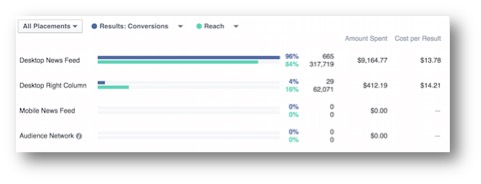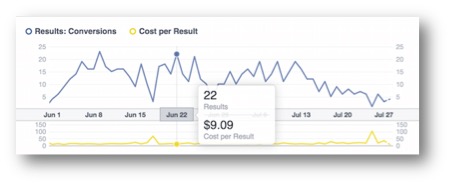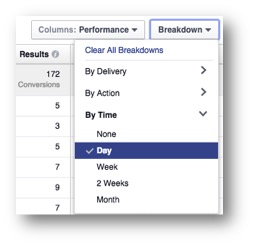A few weeks ago, Facebook updated how cost per clicks (CPC) are measured for advertisers. In essence, Facebook is excluding engagement clicks (likes, comments, shares) from link clicks and is only charging advertisers for link clicks. Depending on your campaign objective, link clicks may include clicks to websites, call-to-action clicks, clicks to install an app, etc. You can learn more about the changes from Facebook’s business blog.
Personally, I’m excited about the change. I think it will help advertisers align their campaigns more with business goals by giving a more accurate picture of how their ads are performing against their objectives. Plus, we can actually compare Facebook ad clicks to other ad platform clicks to get a better understanding of return on ad spend (ROAS).
With this in mind, how do you achieve higher ROAS with Facebook ads? The key is using audience targeting to achieve a better relevancy score. Like Google’s quality score, a higher relevancy score generally equates to lower CPCs and CPAs. Here’s an example of two ads with the same targeting that each lead to very different results.

The ad with a relevancy score of 5 had a 47% cheaper CPA and 37% cheaper CPC over the ad with a score of 3. That’s a huge difference! To get results like this, it starts with your target audience.
Here are five tips on targeting your audience to improve your Facebook ROI.

Tip 1 – Create Audience Personas
Creating and selecting your target audience should be one of your first tasks when crafting a Facebook ad strategy. How you set up your audiences and target them with ads will have the biggest impact on your relevancy score and your CPCs.
Facebook’s platform is set up to easily target users that matter the most to your business. Ideally, you’ll want to base your ads off your customer personas, website traffic and email lists. If your company already has personas then start creating ads using Facebook’s demographic, behavioral, device and location targeting.
Here are few ways to find your audience on Facebook.
- Facebook Audience Insights
- Make sure to take advantage of Facebook audience insights when analyzing your audience to create personas. There is a lot of good information to sort through.
- Website Custom Audiences (Remarketing)
- Install Facebook’s custom audience pixel to create audiences from your website traffic to show remarketing ads.
- Email Lists
- Upload highly segmented email lists into Facebook to target the right people with the right message.
Pro Tips
- Lookalike Audiences. Create new audiences based off email lists and website audiences to find new customers.
- Don’t neglect your fans. Using audience insights, segment your Facebook fans into small audiences to deliver tailored messages.
- Don’t Guess, use Google Analytics. You already have a lot of information. Analyze your website visitor data in Google Analytics to glean valuable insights about customers. Use this data for demographic, device, location and behavioral targeting.
Tip 2 – Relevant Targeting & Placements
Now that your audiences are in place, let’s work on getting more granular. Facebook offers many targeting options to drill down your audience, such as:
- Devices
- Demographics
- Interests
- Behaviors
- Locations
Use these options to build out personas by layering different targeting options.
One thing to keep in mind is that interest and behavior targeting are considered “OR” statements not “AND” statements. For example, let’s say you want to run an ad targeting people with an interest in “travel” and “beaches.”
Facebook will build one audience, including everyone who has an interest in “travel” and everyone who has an interest in “beaches.” Currently, there’s no way to select the people in the interest overlap. You can only target the overlap by using the Facebook API or third party applications.
Below is an example of ad sets broken down by men or women desktop users over the age of 45 with an interest in tourism (we ran another campaign with the same criteria, but only for mobile users).

By narrowing our targeting to specific devices/demographics/interests, we found that men outperformed women with 46 more conversions, but at a 28% higher CPA over the same time period. With this information, we shifted budgets to meet the client’s goals.
Here’s another example of how ads performed in the News Feed versus Right Column.

Pro Tips
- Desktop vs Mobile – Create ads specifically targeting device placements. You could even subdivide desktop by News Feed and Right Hand Column.
- Men vs Women – Run more targeted ads by breaking out men and women.
- Geo-Targeting – You can also add/exclude locations from your campaigns to focus on target market.
- Interests and Behaviors are “OR” statements not “AND” statements.
Tip 3 – Schedule Your Ads Around Your Audience
Knowing when audiences are online will help you show your ads at the right time. Analyze your website traffic and audience insights to find the optimal time(s) to show your ads.
There’s no sense in showing your ads 24 hours a day if your target audience is only online from 6:00 AM – 11:00 PM. Find out when your audience is most active on Facebook, and if there are certain days and hours to schedule your ads to be more effective.
Here’s an example of website conversion peaks and valleys over a 30 day period. I wish it performed like the first week, with a steady increase, but that’s not realistic for this audience.

Next, I recommend reviewing to see if there are any conversions trends by day. Maybe Fridays performed better than Mondays. With this information, I can make sure to allocate budget accordingly.

Pro Tips
- Custom Daily Schedule – If you know what time of day your audience is online, run a daily schedule. Selecting a Lifetime Budget, rather than the default Daily Budget, will allow you to run a custom ad schedule.
Tip 4 – Compelling Images
What does your audience find appealing? Your image should speak to your product or service and your audience. For example, if you’re targeting men and women separately, make sure your ads appeal to them. Or, if you’re targeting different age groups or locations, make sure your images speak to your target audience.
Always run multiple images at the same time to see which one performs the best. Typically, the best performer will have a higher relevancy and cheaper CPC.
Here’s an example of how the same target audience responded to three different images. It’s clear that our audience really liked one of the images in particular leading to more conversions at a cheaper cost per acquisition and higher relevancy score.

The more relevant the image is to the audience the better your audience will respond (CTR) leading to a cheaper CPC or CPA.
Pro Tips
- Optimize images for Desktop and Right Hand Column.
- Rotate your images every 7-10 days to keep it fresh and engaging.
- Use vivid, colorful images.
- Show only parts of people to increase engagement. Like hands holding the product. For more information on this, review this research.
- AdEspresso has also put together excellent ad design tips.
Tip 5 – Enticing Ad Copy
Not to be overlooked is the ad copy. My wife is a copywriter and always reminds me how important messaging is to the success of a campaign. When writing ad copy, think about your reader.
As David Ogilvy said, “Do not … address your readers as though they were gathered together in a stadium. When people read your copy, they are alone. Pretend you are writing to each of them a letter on behalf of your client.”
If you have segmented your audience by demographics, then your writing is just a little easier, because now you’re not trying to accommodate everyone. Now, you can focus your efforts on the features and benefits that will directly appeal to women, men, certain age categories and even location.
One thing I also try to do is qualify the audience with specific messaging. This helps filter people who may not have an interest in what I’m offering and use my budget more efficiently and effectively.
Ad copy is both an art and science. It takes a lot time and effort to produce great copy.
Pro Tips
- Know your audience and be authentic.
- Always test! Never become complacent with your messaging. It can always be improved for better results.
- Make sure your ad copy matches your landing pages.
- Check out Facebook’s Ad Copy Cheat Sheet.
Conclusion
Spend the extra time conducting research on your market audience by building out personas to target in Facebook.
Your reward for combining all these targeting techniques is a highly customized ad for your audience that should net excellent ROI. In the end, you don’t want to crash user news feeds. Be enticing, not annoying, and audiences just may reward your ad with free organic reach.
Got another tactic that you use for targeting your audience on Facebook? I’d love to hear about it in the comments section.


